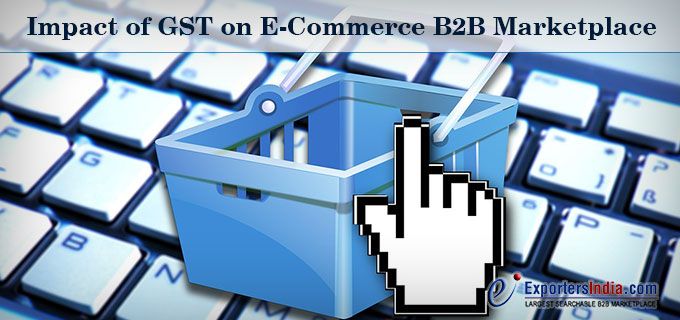Impact of GST on the E-Commerce B2B Marketplace

With less than 10 days left for the Goods and Services Tax aka GST to be implemented in India, discussions have warmed up among the shrewd account and finance heads of the nation about its effect on nation’s economy. GST, one of the biggest reforms in the Indian taxation system, would roll out on 1st July 2017 and is expected to have a lasting impact on various sectors. One of the most crucial sectors to be talked about in terms of GST impact is the e-commerce sector.
Although India’s e-commerce market will expectedly touch a whopping $100 billion benchmark by the end of 2020, it still remains to be the most vulnerable to multiple tax issues. By standardizing and simplifying the tax structure through the GST tax reform, it is expected that the market would become more transparent. The B2B e-commerce portals would become regularized in their taxation and its ultimate benefit would be on the common masses. However, before we make any strong conclusion, let’s have a look at other impacts that GST is expected to have on the e-commerce marketplace.
Impact of GST on E-Commerce
- Standard Tax Rate For Each Product
GST, with its uniform tax slabs for various products, would bring standardization in the price of all the products sold in the online marketplace. Presently, different VAT rates are being imposed on certain goods in different states. E-commerce retailers, merchants and used to take undue advantage of tax arbitrage by entering into exclusive tie-ups. Post the implementation of GST, this would become impossible and ultimately, no extra cost would be added to products. This would lead to a standard rate of each product by each and every online seller in the business to business e-commerce scenario. - No More Tax Cascading
In the present scenario, tax cascading is one of the biggest problems faced by the online marketplace. With the standard Goods and Services Tax being implemented from 1st of July, this problem of tax cascading would be completely removed. Post GST, the cross-utilization of credits would be allowed which would facilitate the supply chains with seamless credit. As the tax set-offs, available for production value chains, would now be brought into both the goods and services, it would result in the tax cascading being reduced to zero. The overall cost of supplies would be brought down and the customers would be benefitted from this. - Mandatory Registration for All
As there is no threshold limit kept for the online marketers under GST, it would become mandatory for all the businesses to register under this new tax rule. Irrespective of the turnover made by the business, each business carrying out an e-commerce activity would have to become registered under GST or they would be weeded out. As all the online sellers would now be registered, there would be standardization in the taxes charged by all the e-sellers. Therefore, the product pricing would now become uniform post GST implementation. - Tax Collection at Source
Tax Collection at Source aka TCS means that the B2B e-commerce platform operators would have to deduct a 2% tax per every transaction from the sellers’ payment and this amount would be deposited with the government. Only the online retailers would be included in the TCS system under GST and all the offline retailers would be excluded from this regime. This would result in a more filtered selection of B2B e-commerce platforms by the retailers and even the withdrawal of a number of smaller firms from the online business portals as it would not bring the envisaged benefits. - Issue of Return Matching
All the monthly supply details and the amount collected from these supplies along with the statement by the operator would be matched with the corresponding supplier’s details regarding the outward supplies that he has filed. If there is any discrepancy which stays unresolved between the supplier and the operator, the supplier would be liable to pay the needful tax along with the calculated interest. This would make the transactions transparent and the details about supplies clearer.
The much-awaited Goods and Services Tax would become fully functional on 1st July 2017 and would hopefully be a boon for all the e-commerce trading platforms. Till then, let’s cross our fingers and wait for the GST era to mark its beginning.
Category Tags

Add Comment